Technically speaking, the first-ever five-color card printed in the history of Magic was a single promotional card printed for the 1996 World Champion. That’s some free bonus trivia to start your week. But if we want to talk about the real first WURBG-mana card in Magic, that would be this royal beauty:
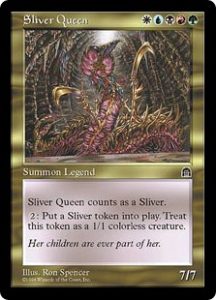
Sliver Queen was the holy grail of the Sliver deck for half a decade. It’s worth noting that, pre-Fetchlands, pre-shocklands, hell, pre-enemy-painlands, paying all five colors was a huge ask. You were running City of Brass and as many awful tap lands as you could stomach, or were building a base-green ramp deck off Rampant Growth and Harrow. This is how Slivers truly claimed the Casual Mind—against tournament decks, they floundered, but at the kitchen table, with fewer Armageddons and Forbids and Jackal Pups, they dominated.
It wasn’t just the mana that made Sliver Queen notable. Back in those days, Magic didn’t have token production at this rate. The Hive was a desirable card, so paying two mana for repeatable tokens was huge. Even though card advantage wasn’t understood to the extent it is now, it was clear that being able to produce threats without expending cards was powerful. Sliver Queen, assuming you were able to muster the mana, asked a pittance of you to produce 1/1 tokens—or, as was often the case with Sliver decks, 5/5 Flying, Shroud, “Sacrifice this to gain 4 life” tokens.
Sliver lords would of course become a thing. Costing WURBG stuck around as well:
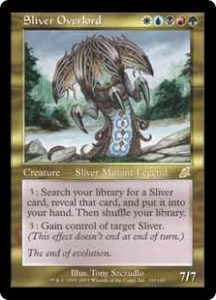
We went five years between Slivers—the next were three cycles in Legions, with the Overlord coming in Scourge. As much as I love Sliver Queen, the Overlord is my favorite design. Tutoring up silver bullets—Sliver bullets??—is a big game. Turning your opponents’ creatures into Slivers via Unnatural Selection, Mistform Mutant, or Blades of Velis Vel is even better.
Unfortunately, it does become pretty linear—tutor up Quick Sliver, then Crystalline Sliver, then Root Sliver, then Might Sliver or Magma Sliver or Sliver Legion and attack for a million. It’s much closer to a Vengevine-fueled Survival of the Fittest than a true toolbox card, but it’s still great to instant-speed tutor up Slivers—especially with Training Grounds in play.
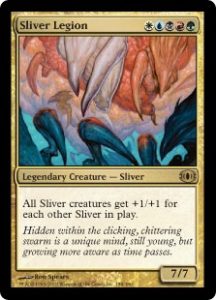
Future Sight gave us Sliver Legion, the lord of all lords. Coat of Arms on a 7/7 wins games, but it’s supremely boring. It’s good to have a haymaker, especially one that wins games with Galerider Sliver and a couple +X/+X Slivers of your choice. But between the math and the mana, the Legion is as straightforward and dull as they come. The most interesting part of the card is the flavor text—presumably, this is the new queen, protected by a cocoon of flesh, ready to take her throne in the future. As of this summer, we’ve seen the First Sliver. One day, no doubt, we’ll see the Last.
As the predecessor of Modern Horizons, it makes sense for Time Spiral block to be laden with Slivers. I’m glad it was, as it led to one of my favorite Pro Tour moments, when Jacob Van Lunen and Chris Lachmann won off the backs of Virulent and Bonesplitter Slivers. Before Infect, there was a common one-drop who poisoned the opponent to death before they could get their shields up, and that wouldn’t have happened without Future Sight and its host of hivelings.
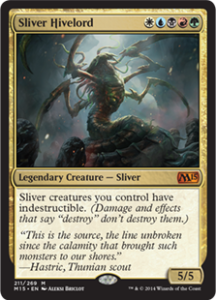
Some vocal players see M15’s Slivers as a mockery of the creature type—by affecting only their controller’s Slivers and changing the iconic look of the original, they argue it dilutes the joy of a Sliver deck. I don’t agree, but I do see their point when I look at the Hivelord. It’s a vital piece of a Sliver deck, but it’s not a 7/7. Plus it disrupts the predictable pattern of Legendary Slivers, embodying the changes foisted upon the classic casual tribe.
Aesthetic changes aside, the Magic 2014 and 2015 Slivers did give us more tools for more competitive Sliver decks—from Adam Bowman’s Modern deck to the critical mass of common lords now available for Pauper—and I respect what those sets brought.
Indeed, as someone drawn towards postmodernism, I outright like the Hivelord—their 5/5 stats squarely reflect their casting cost, which is aesthetically laudable. Most of all, I enjoyed how it disrupted the expectation of Slivers, in a way that only the Hivelord could: imagine the stultifying grind of “Slivers have Indestructible” in a mirror match. With Hivelord and Legion, there’s no choice, no excitement, just two big, boring doofuses who end the game in short order.
The Hivelord is a bit different, however—Sliver Hivelord confronts you with the expectation of what a Legendary chromatic Sliver will be, then fails to meet those expectations. If you ask an enfranchised player what a Legendary Sliver looks like, they’ll tell you it’s a 7/7 for WUBRG. They’ll be wrong, of course. Three in a row is a trend, not a guarantee; so I praise the Hivelord for bucking expectations.
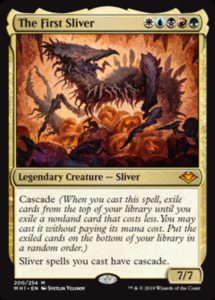
That said, tradition counts for something. The only Sliver deck I’ve run was my Sliver Overlord Commander deck. I found that deck too linear and math-heavy to be truly enjoyable, but I’m tempted anew by The First Sliver.
Cascade is right below Storm on the list of mechanics too powerful to return in force in a tournament-legal set, so to have it appear on a Legendary Sliver feels as exciting as the first time I saw Sliver Queen in a Stronghold booster. The Cascade chains you’ll get out of this will get absurd very quickly, and it’s made me pull Maelstrom Nexus out of my trade binder for the first time since 2011. Nameless Inversion somehow gets even more value, and Hibernation Sliver is suddenly more than an also-ran.
I think Slivers are a possibility in Modern, if a distant one. Between Cavern of Souls, Mana Confluence, Sliver Hive, and Unclaimed Territory, you can cast anything tribal you want. And Aether Vial can change combat math at a moment’s notice. This seems like a weaker Humans deck, of course; so unless something changes, I expect to see Humans played more often than Slivers.
Something may yet change, though. Canonically, the Dominarian Slivers still live. The last remaining members of the Rathi Sliver line were plane-shifted to Dominaria, destroyed, then revived, Jurassic Park-style, by the Riptide Project. They might be governed by either the fused mass of Riptide Slivers (basically a rat-king of Slivers) or the “unique mind” mentioned on Sliver Legion. Per Mark Rosewater, Slivers almost returned last year in Dominaria, but there wasn’t space to do the tribe justice. Modern Horizons is quite a consolation prize, but I expect Slivers to return before too long. When they do, I’ll be rooting for them—and a fair portion of the audience will be holding their breath for the sixth Legendary Sliver.
A lifelong resident of the Carolinas and a graduate of the University of North Carolina, Rob has played Magic since he picked a Darkling Stalker up off the soccer field at summer camp. He works for nonprofits as an educational strategies developer and, in his off-hours, enjoys writing fiction, playing games, and exploring new beers.

